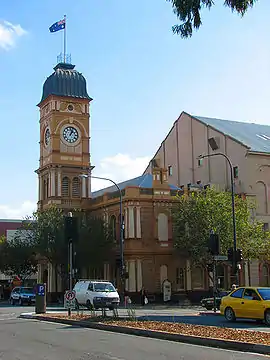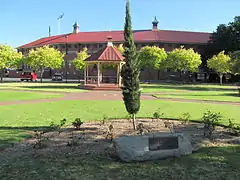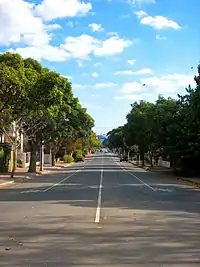Norwood, South Australia
Norwood is a suburb of Adelaide, about 4 km east of the Adelaide city centre. The suburb is in the City of Norwood Payneham & St Peters, the oldest South Australian local government municipality, with a city population over 34,000. It has become an extremely popular place to live and housing prices reflect accordingly.
| Norwood Adelaide, South Australia | |||||||||||||||
|---|---|---|---|---|---|---|---|---|---|---|---|---|---|---|---|
 The Norwood Town Hall on The Parade | |||||||||||||||
| Population | 5,953 (2016 census)[1] | ||||||||||||||
| Established | 1847 | ||||||||||||||
| Postcode(s) | 5067 | ||||||||||||||
| Location | 4 km (2 mi) from Adelaide | ||||||||||||||
| LGA(s) | City of Norwood Payneham & St Peters | ||||||||||||||
| State electorate(s) | Dunstan | ||||||||||||||
| Federal Division(s) | Sturt | ||||||||||||||
| |||||||||||||||
History
Norwood is named after Norwood, London. It was first laid out in 1847.[2]
Trams
The first permanent street-based public transport service in Adelaide was provided in Norwood and Kensington, and these suburbs were also the first to be served by electric trams. The Adelaide and Suburban Tramway Company, the first horse-drawn tram company, started laying tracks from the City of Adelaide to Norwood and Kensington in 1877, with the first trams running in June 1878. The Adelaide and Suburban Tramway Company was acquired by the Municipal Tramways Trust, and the Kensington line converted to an electric tramway in 1909. The interim Kensington terminus was at The Parade/Gurrs Road intersection, before being extended, as part of the network of Adelaide trams, to serve the recently created reserve up The Parade at Kensington Gardens.[3]
Until 1952, the service was linked in with the other eastern suburbs tramlines and terminated in the city, but in that year it was "though routed" with trams running to Henley Beach. The tramway closed in February 1957.[3]
Jubilee Cycling Arena
In February 1951 the Jubilee Cycling Arena, aka Norwood Velodrome, opened on Osmond Terrace. It was a steeply banked concrete velodrome, with six laps to the mile, designed by Eddie Smith. During the summer, there were races held every Friday night. It became a popular spot for keen cyclists,[4] and was also used as a venue for square dancing in the 1950s.[5] In 1965 over A$11,000 was raised by cyclists to re-concrete the track.[6] In 1970, residents organised protests and a green ban in order to stop the destruction of the Norwood Velodrome for high-rise apartments.[7] However, Norwood Council sold the velodrome and surrounding land to real estate developers.[6]
Geography
The suburb consists of four segments, being divided into north and south by the major thoroughfare of The Parade and east and west by Osmond Terrace. It is bounded on the south by Kensington Road on the north by Magill Road, on the east by Portrush Road and on the west by Fullarton Road. It is a leafy suburb, with streets lined with plane trees.
Osmond Terrace is a street with a wide grass, median strip featuring a prominent war memorial commemorating ANZAC soldiers who fought in the first and second World Wars, sculptures from local artists and numerous rose gardens.
The most visible landmarks in Norwood are the Norwood Town Hall and the Clayton-Wesley Uniting Church (previously Clayton Congregational Church) on the north east corner of Portrush Road and The Parade. Actually located in Beulah Park, the church, built over 150 years ago, is visible all the way up The Parade westwards.
Demography
Norwood attracted many European migrants post-World War II. It still has a very high concentration of people of Italian background.[8] This is reflected in the restaurants and fashion boutiques of The Parade.[9] Norwood's heritage and bohemian character can be ascertained from the political voting patterns; it had been more left-wing in nature than the other eastern suburbs around it, however affluent conservatives have flipped that in recent elections.
Transport
Several Adelaide Metro bus routes serve the suburb. These are the main routes running through or adjacent to Norwood as of 2020:[10]
- H30, H33: Magill Road
- H20, H21, H22, H23, H24, N22: The Parade
- 140, 141,142: Kensington Road
- 300: Suburban Connector (Portrush Road)
In addition to these, there are a number of school services running during term-time, and special services to Adelaide Oval for big events.[10]
Sport

Norwood Oval, on The Parade, is home to the Norwood Redlegs, a South Australian National Football League (Australian Rules Football) team. Former home of the Adelaide Giants baseball team.
Attractions

The queen of Adelaide's eastern suburbs: hip, sassy and smitten with cafe life. The parade contains the business centre of the suburb, which includes some professional services but it is better known for its restaurants, cafes, fashion boutiques and hairdressers.
Odeon Theatre
The Star Theatre is on the corner of The Parade and Queen Street. Originally the Star Theatre, with its entrance on The Parade, the operator was D. Clifford Theatres/Star Theatres by 1946. Later it was taken over by Greater Union Cinemas and renamed the Odeon Theatre. It closed as a cinema, reopening in 1986 as a live theatre specialising in children's productions, at which time the entrance was moved around the corner onto Queen Street, and the original foyer converted into restaurant[11] (as of 2020 St Louis[12]).
As of 2020, the venue is home to Australian Dance Theatre, which offers dance classes to adults. The venue is hired out for various performing arts events,[13] such as the Adelaide Festival,[14] Adelaide Fringe[15] and State Theatre Company of South Australia performances.[16]
Churches
Saint Bartholomew's (St Bart's) in Norwood and St Matthew's in nearby Kensington are two churches with a close association with each other, with three church ministers involved in both congregations. They are both evangelical and conservative Anglican churches, with a large number of young adult members.
Saint Ignatius Catholic Parish Church, built in the 1860s by the Society of Jesus (more commonly referred to as Jesuits) and finished by 1872, is also a significant feature in the suburb. The accompanying presbytery housed Mary MacKillop, founder of the Sisters of St Joseph of the Sacred Heart, where she took refuge after her (temporary) excommunication by Bishop Sheil.
Notable residents
Many famous South Australians have resided in Norwood, including:
- women's rights campaigner Catherine Helen Spence
- former Premier Don Dunstan
- politician Reginald Blundell
- public servant and Australian Army officer Stanley Price Weir
- Australia's first beatified saint Mary MacKillop
- writers C.J. Dennis and May Gibbs
- film director Mario Andreacchio
- chef and artist Poh Ling Yeow
- former Police Officer and Police Commissioner Alexander Tolmer
References
- Australian Bureau of Statistics (27 June 2017). "Norwood (State Suburb)". 2016 Census QuickStats. Retrieved 8 August 2019.

- "The History of Kensington & Norwood". Archived from the original on 20 July 2008.
- "The Eastern Lines". Tramway Museum, St Kilda. 17 March 1956. Retrieved 20 September 2020.
- "Cycling". Victor Harbour Times. 44 (2170). South Australia. 26 November 1954. p. 4. Retrieved 20 September 2020 – via National Library of Australia.
- "The Odd spot". The News (Adelaide). 60 (9, 266). South Australia. 22 April 1953. p. 3. Retrieved 20 September 2020 – via National Library of Australia.
- "Club History". Norwood Cycling Club. 10 March 2014. Retrieved 20 September 2020.
- Burgmann, Verity and Meredith (1998). Green Bans, Red Union: Environmental Activism and the New South Wales Builders Labourers' Federation. p. 52.
- >Australian Bureau of Statistics (25 October 2007). "Norwood (State Suburb)". 2006 Census QuickStats. Retrieved 4 September 2015.
- "The Parade". Theparadenorwood.com. Retrieved 4 September 2015.
- "Search Results [Norwood]". Adelaide Metro. 12 February 2020. Retrieved 20 September 2020.
- "Odeon Norwood in Adelaide, AU". Cinema Treasures. 17 February 2018. Retrieved 29 July 2020.
- "Home - House of fine ice cream & dessert". St Louis Ice Cream Adelaide. Retrieved 29 July 2020.
- "The Odeon Theatre - Australian Dance Theatre". The Parade. Retrieved 29 July 2020.
- "Odeon Theatre". Adelaide Festival. Retrieved 29 July 2020.
- "Events located at The Odeon Theatre". FringeVault. Retrieved 29 July 2020.
- Cornelius, Patricia (11 December 2018). "In the club". State Theatre Company. Retrieved 29 July 2020.
External links
| Wikimedia Commons has media related to Norwood, South Australia. |